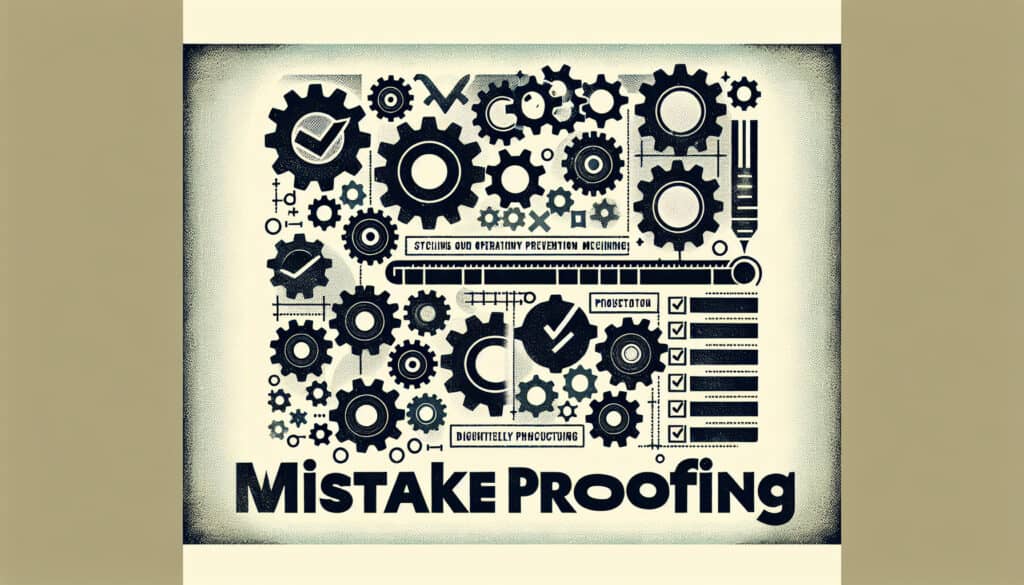To prevent errors from occurring in a process.
- المنهجيات: لين سيجما, تصنيع
تدقيق الأخطاء (بوكا يوك)

تدقيق الأخطاء (بوكا يوك)
- التحسين المستمر, التصميم من أجل التصنيع (DfM), منع الأخطاء, التصنيع اللين, بوكا يوكي, تحسين العمليات, ضمان الجودة, مراقبة الجودة, سداسية سيجما
الهدف:
كيفية استخدامه:
- A Japanese term that means 'mistake-proofing'. It is a technique for preventing errors by designing processes and products in a way that makes it impossible for errors to occur. For example, a USB plug can only be inserted in one direction.
الايجابيات
- Prevents errors from occurring, which improves quality and safety; Can reduce costs and improve efficiency.
سلبيات
- Can be difficult to implement for all types of errors; May not be a substitute for training and supervision.
الفئات:
- لين سيجما, تصنيع, الجودة
الأفضل لـ
- Designing products and processes in a way that prevents errors from occurring, such as in a manufacturing assembly line.
Poka-Yoke techniques can be applied in various sectors such as automotive manufacturing, healthcare, electronics, and food processing, where minimizing errors is paramount. During the design phase, engineers and designers collaborate to identify potential failure points within a process or product, enabling the implementation of fail-safe mechanisms before production begins. For instance, in a manufacturing assembly line, fixtures can be designed to guide components into correct positions, while in software development, user interfaces can include prompts that prevent data entry errors. Quality control teams often integrate Poka-Yoke principles to enhance inspection processes by employing checklists or automated systems that flag inconsistencies. This methodology can be initiated by project managers or quality engineering teams, encouraging involvement from cross-functional teams including production workers who can provide insights on practical challenges faced on the shop floor. Industries such as healthcare utilize Poka-Yoke through medication dispensing systems that ensure patients receive the correct dosage, emphasizing patient safety and operational efficiency. The implementation of these techniques not only enhances quality but also leads to significant cost savings, as the expenses associated with rework, waste, and customer complaints diminish. By embedding error-prevention measures directly into processes, organizations cultivate a culture of continuous improvement, reinforcing accountability among employees while fostering operational reliability.
الخطوات الرئيسية لهذه المنهجية
- Identify potential failure modes in processes or products.
- Evaluate the impact and frequency of identified failure modes.
- Develop solutions that eliminate or reduce the likelihood of errors occurring.
- Implement Poka-Yoke devices or methods in the design process.
- Test the effectiveness of the implemented solutions under real conditions.
- Iterate on the design based on feedback and error occurrence rates.
- Educate users about the Poka-Yoke features in the design.
- Establish a monitoring system for ongoing error detection and prevention.
نصائح للمحترفين
- Integrate error detection sensors in assembly lines to provide immediate feedback on incorrect part positioning or insertion to prevent defects.
- Design interchangeable components that can only fit in one way or are distinguishable by tactile cues, reducing the risk of assembly errors.
- Implement standardized work processes with visual aids and limits on part usage to curb mistakes during repetitive tasks on the manufacturing floor.
لقراءة عدة منهجيات ومقارنتها, نوصي باستخدام
> مستودع المنهجيات الشامل <
مع أكثر من 400 منهجية أخرى.
نرحب بتعليقاتكم على هذه المنهجية أو المعلومات الإضافية على قسم التعليقات أدناه ↓، وكذلك أي أفكار أو روابط متعلقة بالهندسة.
منشورات ذات صلة
استبيانات الانزعاج العضلي الهيكلي
الاختبار متعدد المتغيرات (MVT)
تحليل الانحدار المتعدد
أنظمة التقاط الحركة
طريقة MoSCoW
اختبار متوسط المزاج